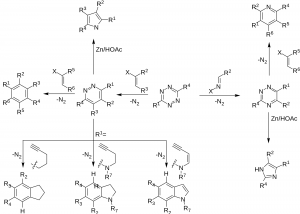Local Activation of Chemotherapy

Tetrazine Explosion Diagram for DAinv
Anti-cancer drugs that only activate at a tumor site has been an area of pharmacology interest for about 20 years, particularly for prostate cancer. In this piece, clinical chemists at the SUNY-Albany describe a two-step process for chemo localization: first, they inject a biocompatible hydrogel containing an unstable compound of tetrazine near a tumor site. Then, they infuse a pro-drug form of doxorubicin. “When the pro-drug and the hydrogel come near, the bioorthogonal agents react with each other through the IEDDA reaction localizing the payload. The multivalency of the hydrogel’s surface provides a large number of tetrazine groups capable of concentrating the systemically administered small molecule pro-drug, thus compensating for its suboptimal pharmacokinetic properties. Finally, the resulting intermediate isomerizes spontaneously releasing the active drug from the hydrogel to perform its therapeutic function locally.” MORE
Image Credit: en.wikipedia.org


